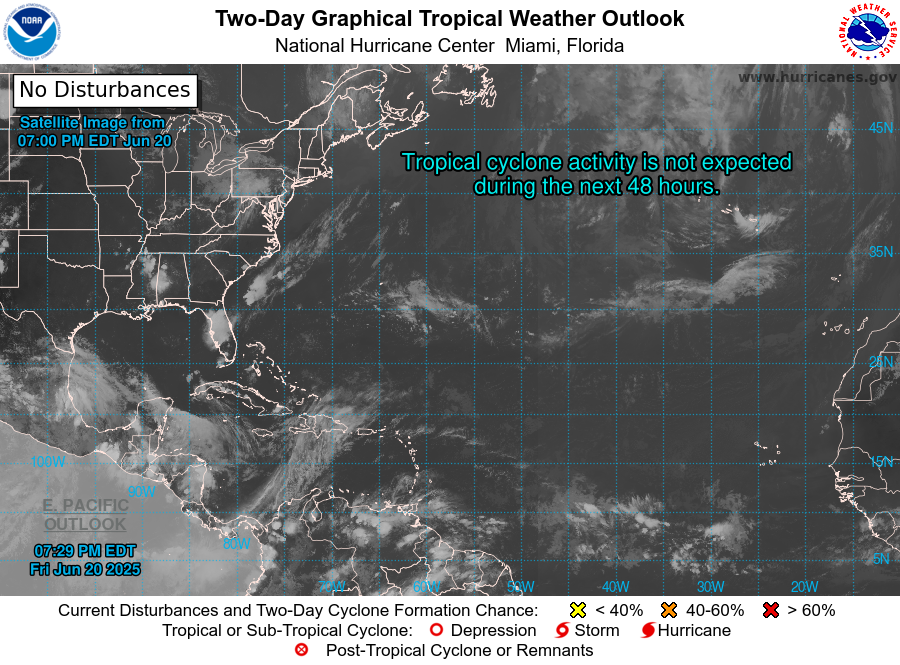Hurricane Season LIVE Jun 1-Nov 30: Prepare, Be Vigilant, Take Action, Seek Shelter, Recover.
See NOAA’s Climate Prediction Center Atlantic Hurricane Season forecasts and updates. The average hurricane season produces 12 named storms, of which 6 become hurricanes, including 3 major hurricanes. Increased hurricane activity is attributed to the warm phase of the Atlantic Multi-Decadal Oscillation (AMO), which began in 1995, and has historically lasted about 25 to 40 years. See also forecasts for the Atlantic hurricane season from Colorado State University (CSU) hurricane researchers.
Tropical Atlantic wide view:GOES-East - Tropical Atlantic wide views (each link below opens in new window):
- GEOCOLOR-900x540.gif (larger view of above); and Clean Longwave (IR) (.gif);
- AirMass-900x540.gif (RGB composite); and Upper Level Water Vapor (.gif).
U.S. Gulf Coast here (opens in new tab or window)
Caribbean view here (opens in new tab or window)
UPDATES on all Atlantic Tropical Cyclones & Disturbances at nhc.noaa.gov
Glossary of NHC Terms excerpt: Tropical Storm: A tropical cyclone in which the maximum sustained surface wind speed (using the U.S. 1-minute average) ranges from 34 kt (39 mph or 63 km/hr) to 63 kt (73 mph or 118 km/hr). NHC Letter Designations:D: Tropical Depression – wind speed less than 39 MPHThe hurricane season is officially June 1 to November 30. More info: 2020 Atlantic Hurricane Season | wikipedia.org. Also note that five-day Atlantic Hurricane forecasts in 2017 were as accurate as two-day forecasts in 1998 due to more powerful supercomputers.
S: Tropical Storm – wind speed between 39 MPH and 73 MPH
H: Hurricane – wind speed between 74 MPH and 110 MPH
M: Major Hurricane – wind speed greater than 110 MPH
See also Hurricane Strikes in Continental U.S. 1950-2011 (png) and graphic of FL data 1900-2010.
Links:
Links:
- US Coast Guard "For COTP-specific Port Hurricane Conditions, you should review information provided under the Port Directory tab of https://homeport.uscg.mil/"--District 7 Local Notice to Mariners, 20 May 2020 (pdf), excerpt:
Condition 4 – Hurricane Seasonal Alert. 01 June–30 November; port status: open.
Condition Whiskey – Sustained Gale Force winds (39–54 mph, 34–47 knots, 63–87 km/h), associated with Tropical Cyclone activity are predicted within 72 hours; port status: open.
Condition X-Ray – Sustained Gale Force winds associated with Tropical Cyclone activity are predicted within 48 hours; port status: open.
Condition Yankee – Sustained Gale Force winds associated with Tropical Cyclone activity are predicted within 24 hours; port status: restricted; vessel/facility control measures in effect.
Condition Zulu – Sustained Gale Force winds associated with Tropical Cyclone activity are predicted within 12 hours; port status: closed to all vessel traffic and waterside activities except for activities approved by the COTP [Captain of the Port].
- FPL.com | Florida Power & Light storm response, safety tips, business and personal preparation guides.
- 2018 Atlantic hurricane season | Wikipedia.org; hurricane seasons 2017 and 2018;
- On twitter: @NHC_Atlantic (embed below), @NHC_Surge and @NOAASatellites.
(Notes: on some devices or browsers, reload to update / refresh images and info provided by sources above; original title: 2019 Atlantic Hurricane Season Forecasts & Updates)
A Look Back at the 2019 Hurricane Season:
Above Sep 2, 2019: Category 5 Hurricane Dorian over Grand Bahama Island, threatening Florida, before turning and moving northward, offshore Florida's east coast. On Sunday, Sep 8, 2019, Dorian weakened to less than "hurricane-force winds" over the North Atlantic. Dorian's cumulative wind history (graphic opens in new tab / window). The 2019 Atlantic hurricane season was above normal with 18 named storms, 6 hurricanes, and 3 major hurricanes of which Dorian was the most powerful with maximum winds of 185 mph (298 kph). More here.
“He knew too what it was to live through a hurricane with the other people of the island and the bond that the hurricane made between all people who had been through it. He also knew that hurricanes could be so bad that nothing could live through them.”― Ernest Hemingway, Islands in the Stream






